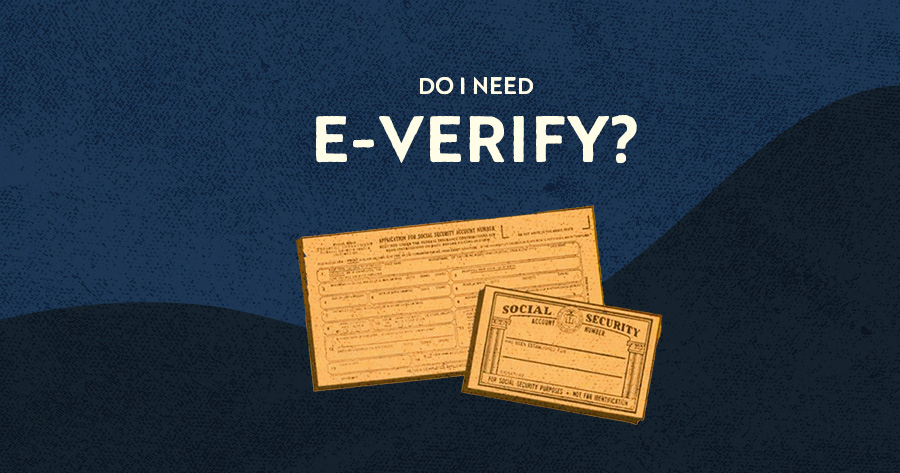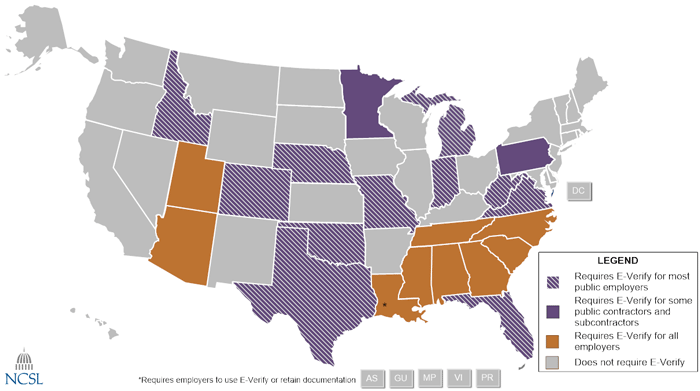
U.S. laws require employers to only employ people who are legally authorized to work in the United States.
What is E-Verify?
E-Verify is a web-based system that determines an employee's eligibility to work in the United States. It compares the information from an employee’s Form I-9 (Employment Eligibility Verification) to data from Social Security Administration and Department of Homeland Security records to confirm their eligibility for employment.
E-Verify does not:
- Verify immigration status
- Allow you to selectively verify employees based on ethnicity or country of origin
- Provide protection from worksite enforcement
- Allow a case to be created without a Social Security Number (SSN)
- Allow you to submit expired documents (except for remote workers)
- Require you to immediately terminate employees because of a TNC
What is an I-9?
Form I-9 verifies the identity and employment authorization of individuals hired for employment in the United States. It confirms that your new employee is eligible and legal to work in this country.
Federal law requires that every employer who recruits, refers for a fee, or hires an individual for employment in the U.S. must complete Form I-9, Employment Eligibility Verification. Form I-9 will help you verify your employee's identity and employment authorization.
Who needs to complete an I-9 Form?
An I-9 form must be completed by every single employee, whether they're seasonal, part-time, or full-time. It is mandatory for every business and employer in the United States.
The I-9 must be submitted no later than the 3rd business day after the employee's first day. Both employers and employees must complete Form I-9.
Who Needs E-Verify?
While Form I-9 is mandatory, E-Verify is state and size-dependent. For example, Tennessee requires you to complete E-Verify if you have 35 or more employees, but Arizona requires it if you have one employee or more.
Some states, such as California and Arkansas, do not have a requirement. However, the following states do require E-Verify:
- Florida
- Alabama
- Arizona
- Colorado
- Florida
- Georgia
- Idaho
- Indiana
- Louisiana
- Michigan
- Minnesota
- Mississippi
- Missouri
- Nebraska
- North Carolina
- Oklahoma
- Pennsylvania
- South Carolina
- Tennessee
- Texas
- Utah
- Virginia
- West Virginia

What are the Steps to E-Verify?
The social security number on Form I-9 is what you put into E-Verify to confirm your employee's identity and eligibility to work for you in the United States.
E-verify is fast, simple, and free. It breaks down into three easy steps:
- Create a case. E-Verify creates a case with the employee's information.
- Receive your results. An initial case result is displayed.
- Close the case. Depending on your result, you will close the case immediately, but some results require additional action.
What documents does E-Verify accept?
It is important to note that you, the employer, cannot specify which documents the employee presents in order to validate their eligibility and be verified. It is considered an unfair immigration employment practice.
- Your employee can either present a document from List A, which establishes both their identity and employment authorization OR;
- Your employee can present a document from List B which establishes their identity, AND a document from List C which confirms their employment authorization.
Visit the U.S Citizenship and Immigration Services website to see which documents fall under each category.
It's important to note that E-Verify does not accept:
- Laminated, plastic, or metal Social Security Cards
- Photocopies of documents
- Printed Social Security Documents
- Expired documents other than a U.S Passport or an item from List B
If your employee doesn't have a social security number, you can require them to bring additional information, which E-Verify uses to validate their identity via photo-matching technology. They can bring:
- Permanent Resident Card (Form I-551)
- Passport
- Driver's License
- Employment Authorization Document (Form I-766)
If your employee hasn't given you any of the listed documents above, they have to show you a receipt that proves that they've applied for said documentation.
If they've applied for a Social Security Number, they can keep working until they've received their SSN, but it must be within 90 days.
What are the results of E-Verify and what do they mean?
The possible E-Verify case results are as follows.
1. Employment Authorized
Information from the Social Security Administration or the Department of Homeland Security has matched the employee's records. Good news - your employee is authorized to work for you. No additional action is required.
2. Verification in Process
This means that the case has been referred to the Department of Homeland Security and they need more time to verify the results. Neither you nor your employee can do anything at this time but wait on results and check E-Verify. This process usually takes anywhere from 1-3 days.
3. Tentative Nonconfirmation (TNC)
The employee's records and information did not match. This can happen for two reasons:
- You, the employer, did not enter the employee's information correctly into E-Verify.
- The employee's documents are invalid or expired.
E-Verify will issue you a Further Action Notice. It's the employee's choice whether they want to address the issue, and if so, they will have to provide different documents, visit a social security office, or contact the Department of Homeland Security.
As the employer, you cannot delay, fire, suspend, or withhold pay from this employee while they are trying to fix the issue.
4. Case in Continuance
This indicates that the employee has physically visited a Social Security office or called the Department of Homeland Security, but more time is needed to determine the results of the case.
5. Close Case and Resubmit
Usually, this indicates that information on a driver's license or passport is incorrect. For example, their driver's license may say that the employee has blue eyes, but they have brown eyes. You will have to close the case and create a new one.
6. Final Nonconfirmation
This means that the employee visited a Social Security Office or contacted the Department of Homeland Security, but E-Verify can't confirm their identity, so you cannot legally hire this individual.
For more information on E-Verify case results and employee/employer actions, download the E-Verify User Manual.
Why is E-Verify important?
E-Verify ensures that employers uphold employment laws and refrain from receiving legal repercussions or loss of business, such as:
- Fines from the government up to $1,000
- Fines for not being able to locate your I-9 forms
- Fines for not filing I-9 forms
- ICE Audit
- ICE issues a Notice of Suspect Documents (NOSD) that requires you to terminate every worker on the list within 10 business days or face criminal sanctions for employing an employee not authorized to work in the United States.
How do I enroll in E-Verify?
Visit the Department of Homeland Security to enroll in E-Verify after you hire an employee.
You can streamline your I-9 and E-Verify process by partnering with a payroll provider that offers electronic onboarding.The E-Verify website integrates within your payroll platform and centralizes the data, making this simple process even easier.
Partnering with a payroll provider also ensures that you know to complete E-Verify in your state. At Whirks, we strive to educate our clients and offer support when it comes to understanding state laws and regulations.
Topics: